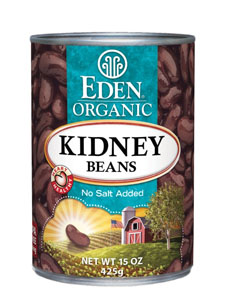

Know the codes on your food packages. Photo courtesy Eden Organics.
November 2005
Last Updated January 2012
|
 |
Food Shelf Life
Start The New Year WIth The Resolution To Keep It Real...Fresh!
CAPSULE REPORT:
According to a study commissioned by Hormel Foods, the kitchen pantry is home to the oldest food items in the kitchen. The study showed that more than one in three Americans (33%) say the oldest food item in their kitchen is a canned good, followed by spices (27%) and condiments (14%). Start the new year by taking inventory of what food is outdated and ready to be replaced.
Here are helpful hints to guide you through the confusing world of expiration dates and storage suggestions, courtesy of Hormel Foods. Start with a clean slate this year and make your resolution to keep the food in your pantry and refrigerator fresh.
Decoding Dates
Here are the four dates that manufacturers may use on food packages:
- Pack Date: The date the food was packaged or processed.
- Sell By Date: Tells the retail store how long to display the food for sale. Foods eaten after this date are usually safe as long as they are handled and prepared safely.
- Best If Used By Date: The food will be of its highest quality or flavor if consumed before this date on the package. Foods may be safely consumed after this date if they are handled and prepared properly and show no signs of spoilage.
- Expiration Date: The last day the food should be eaten. Discard foods not consumed by this date.
How To Store Foods
To get the most out of food items, store each according to these instructions:
- Fresh Meat & Fish: Store meat and fish in the coldest part of the refrigerator (the meat drawer at the bottom is for this purpose). Freeze meat and fish immediately if not planning to use in a day or two.
- Fresh Vegetables: Store up to five days in the crisper or produce drawer of the refrigerator immediately after purchasing. To prevent wilting and decay, only wash right before serving. Tomatoes continue to ripen after harvesting and should be stored at room temperature—never refrigerated—to preserve their flavor. Try a Healthy Harvest Produce Extender—it works!
- Fresh Fruit: Fruit that needs to ripen should be left on the counter (not in the sunlight). Store other fruits up to five days in the crisper or produce drawer of the refrigerator immediately after purchasing. Some fruits, such as apples, are hardy and have a longer shelf life; others, like berries are fragile and may last only a day or two. Ditto about the Healthy Harvest Produce Extender.
- Eggs: Keep in the original carton in the refrigerator in the main body of the refrigerator. Do not store eggs in the refrigerator door where the temperature varies the most (every time the door is opened).
- Breads: Store bread in the original package at room temperature and use within five to seven days. Bread stored in the freezer will have a two to three month shelf-life. Put it in a heavy Ziploc-type bag before freezing to prevent freezer burn.
- Bottled Salad Dressing: Keep in the pantry unopened 10 to 12 months. Once opened, store in the refrigerator no longer than three months.
- Spices & Dried Herbs: Keep in a dry place away from heat or light. Replace if the aroma fades. Whole spices will keep for a year and ground spices will keep six months. Spices may be frozen for longer storage. Read more about checking your spices and herbs for optimal freshness.
- Sugar, Flour, Rice & Other Staples: Keep in airtight containers, for freshness and to keep out insects.
Go To The Article Index Above

|




